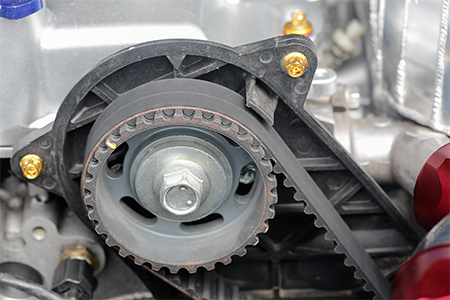A cambelt, also known as a timing belt, may seem like an insignificant part but it is a crucial component of your engines running equipment.
The cambelt is usually made up of rubber and synthetic mix to increase its durability. It has grooves (teeth) on one side which help to enhance the grip on the heads of different shafts within the engine. Without these grooves, the cambelt could slide off at any time.

Is a cambelt the same thing as a timing belt?
You might hear the terms “cambelt” and “timing belt” thrown around, and you’d be right to wonder if they’re the same thing. The answer is yes! Both terms refer to the same essential engine component – a toothed belt that synchronises the crankshaft and camshaft in your car. This keeps the opening and closing of engine valves in perfect time with the piston movement, ensuring smooth operation.
Historically, engines relied on timing chains, made of metal links similar to a bicycle chain. While durable, these chains added noise and required constant lubrication. The shift to timing belts, composed of reinforced rubber, offered a quieter and more efficient solution. Though belts need replacing periodically due to wear, their overall benefits solidified their place as the dominant timing mechanism in modern engines.

What does a timing belt do?
The timing belt synchronises the rotation of the crankshaft and camshaft to keep it timed. In essence, it keeps the bottom half of the engine (pistons and crankcase) in sync with the top half (valves and cylinder head).
Do all cars have a cambelt?
Not all vehicles have a cambelt, though the term “timing belt” and “cambelt” are sometimes used interchangeably.
Many vehicles instead rely on a timing chain, which functions very similarly to a belt but is made of metal links rather than rubber. Both components keep the engine’s valves and pistons in sync, ensuring optimal performance.
If you’re unsure whether your car has a belt or chain, you can consult your owner’s manual or consult a mechanic.
Do Electric Cars have cambelts?
Electric cars don’t have cambelts as they don’t have combustion engines, instead relying on electric motors which have a much simpler design with fewer moving parts. This means electric vehicles have no need for cambelts and the maintenance that comes with them.
When to change the timing belt?
The cambelt is a consumable car part, which means it will need replacing. The material wears over time which makes it more susceptible to breaking. It also becomes more brittle and may become cracked or frayed as a result. The cambelt is also susceptible to stretching which can affect the timing and put it out of sync.
So how do you know when to change your cambelt? Unfortunately, with so many variables, there is no one size fits all when it comes to changing the timing belt.
Most manufacturers suggest either a time or mileage-based change, whichever comes first. However, even the mileage or time suggested can vary massively between both manufacturers and types of engine. It is not unheard of for mileage change recommendations to vary from 40,000 to 100,000-miles or from four to six years.
You should be able to find information regarding your car’s specific cambelt change schedule detailed in your car’s handbook. The figure stated should be treated as an absolute max.
Signs your timing belt needs changing
It can be quite difficult to detect the signs indicating your cambelt need changing, which is one of the reasons you should not ignore manufacturer guidelines or advice from a mechanic.
A few signs you may notice include:
- Lack of power and slow to pick-up speed
- A rattling noise from the cambelt when idling that disappears when the engine is revved. Often this noise is more noticeable when the vehicle is first started in the morning, and the engine is cold.
- There may be a squealing noise if the cambelt is loose.
- Vehicle may not start (in this case the cambelt would be broken meaning the camshaft will not rotate when the crankshaft turns).
As mentioned above, there are often very few cues that your cambelt is failing, and so it may break before you even realise anything is wrong. That’s why it is a good idea to make a visual check of your cambelt from time-to-time. The majority of garages will do this when your car is in for its service, which is just one of the reasons you shouldn’t ignore your service schedule.

Common signs of cambelt wear
It is quite easy to have a look at the timing belt yourself and assess it for wear, once you know the common signs of cambelt wear:
- A worn cambelt may look glazed or glossy on the underside. This indicates the rubber is getting hard and becoming less flexible. Another way to check if the rubber is hardening is to press a fingernail or the tip of a screwdriver gently on the belt, if the pressure doesn’t leave a mark, then the rubber is getting stiff.
- When checking the cambelt, you may notice fraying or cracking on the belt. This is an indication serious wear and damage has occurred and means the cambelt should be replaced as a matter of urgency.
While the cambelt may seem like an insignificant part, it is connected to vital and expensive engine components. This means if it does fail, it can damage more expensive components and result in significant and costly repairs.
It is also worth noting that while the cambelt itself is relatively cheap to replace, fitting can be a complex process, so labour is likely to make up a large proportion of the final bill from your garage. Luckily here at Stoneacre, you can spread the cost of your repairs with our Stoneacre repair payment plan.